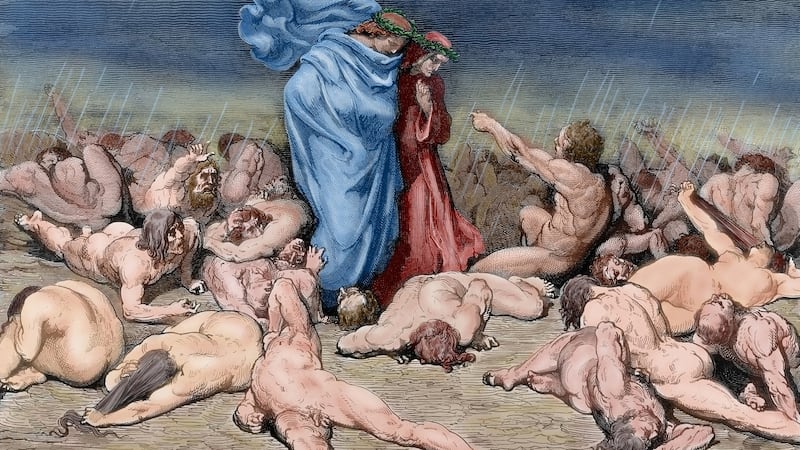Of the three otherworldly destinations he described in his Divine Comedy, Dante's Inferno is by far the best known. But he also visited Purgatory and Heaven. And in his vision of the former, he helped invent what was then a new-fangled concept in most of Christendom, if not in Ireland, where Lough Derg had beaten him to it.
Belief in an intermediate state of the afterlife, where those too good for Hell but unready for Heaven would expiate their sins, went back to biblical times. It was not until 1274, however, that the Vatican defined it as a place. Dante's epic poem, begun 34 years later, was an early public relations triumph for the doctrine.
Purgatory has long been and still is a popular concept in Ireland, where the idea of being repentant sinners seems to suit us better than being saved

It even put Purgatory on the map, literally. In his powerful imagination, informed by the best science of the time (including an awareness that the world was spherical), Purgatory was in the southern hemisphere, directly beneath Jerusalem on a mountain created by the impact of Lucifer’s fall to earth.

In contrast with the Inferno’s nine descending circles, Dante’s Purgatorio had seven ascending terraces, corresponding to the deadly sins but populated by those who had not done nothing bad enough in life to be damned.
Among the people he meets there are Pope Adrian V, serving time for avarice (fifth terrace). Another is Forese Donati (in for gluttony, on the sixth), Dante's childhood friend, fellow poet, and Florentine aristocrat. Speaking of PR, Donati congratulates him on having invented a new style of writing and quotes one of his best lines. Even in Purgatory, Dante did not miss an opportunity for some self-promotion.
The concept of a third place between Hell and Heaven was and continues controversial in Christianity. It was one of the reasons for the split with Eastern Orthodoxy. And the idea of praying for the dead, never mind reducing their time in Purgatory by pilgrimages or other rituals, remained anathema to many Western Christians.
There is an irony that Dante helped popularise it, because he had participated in and been somewhat disturbed by the great pilgrimage of Easter 1300, when Pope Boniface VIII declared the first ever "Holy Year" and many thousands descended on Rome.
That was a financial boon for the Papacy. According to one account, two clerics on the altar of St Peter’s raked the money in – using actual rakes – from indulgence-seeking pilgrims.
The experience may have influenced Dante's evolution on the great political split of his time. Having been born into the Guelfs – who supported the political primacy of the Popes, he ended up a sort of Ghibelline, one of those who favoured the Germanic Holy Roman Emperors.
But a bigger influence, soon afterwards and even more traumatic, was being double-crossed by Boniface VIII, who detained him at the Vatican while a papally-approved coup in Florence condemned the poet to spend the rest of his life in exile.
Although Dante would not meet Boniface in Hell – the latter hadn’t died in time to be included in a book set on the weekend of the Rome pilgrimage – he is assured by another resident there that the treacherous Pope will be arriving in due course.
The poem also expressed the loneliness of Dante's own long exile, which ended in Ravenna 700 years ago this week
Purgatory has long been and still is a popular concept in Ireland, where the idea of being repentant sinners seems to suit us better than being saved. We probably didn’t need Dante to promote the idea. And in fact, his Divine Comedy was not the first major literary treatment of the subject.
Almost a century before the Church formalised its doctrine, an English monk had written of an Irish knight who descends into St Patrick's Purgatory, a cave on Lough Derg, Co Donegal, and emerges to tell the tale. The adventures of Knight Owain, first published in 1180, became a blockbuster of the Middle Ages, translated into at least 30 European languages.
It cemented the fame of a pilgrimage first recorded 30 years earlier but rooted in the legends of Ireland’s patron saint. Dante would almost certainly have heard of it. A fresco depicting St Patrick’s Purgatory has been found in a convent in Umbria, dated 1346.
In his own version, the seven terraces of Purgatory lead penitents back to the Garden of Eden, and lost innocence. But the poem also expressed the loneliness of Dante’s own long exile, which ended in Ravenna 700 years ago this week. Every evening at dusk there, in the park beside his tomb, a bell recalls the plaintive opening lines to the Purgatorio 8th canto:
“It was, by now, the hour that turns to home/the longing thoughts of seamen, melting hearts/the day they’ve said goodbye to dearest friends;/and when by love the pilgrim, new to this/is pierced to hear, far off, the evening bell,/That seems to mourn the dying of the day.”









